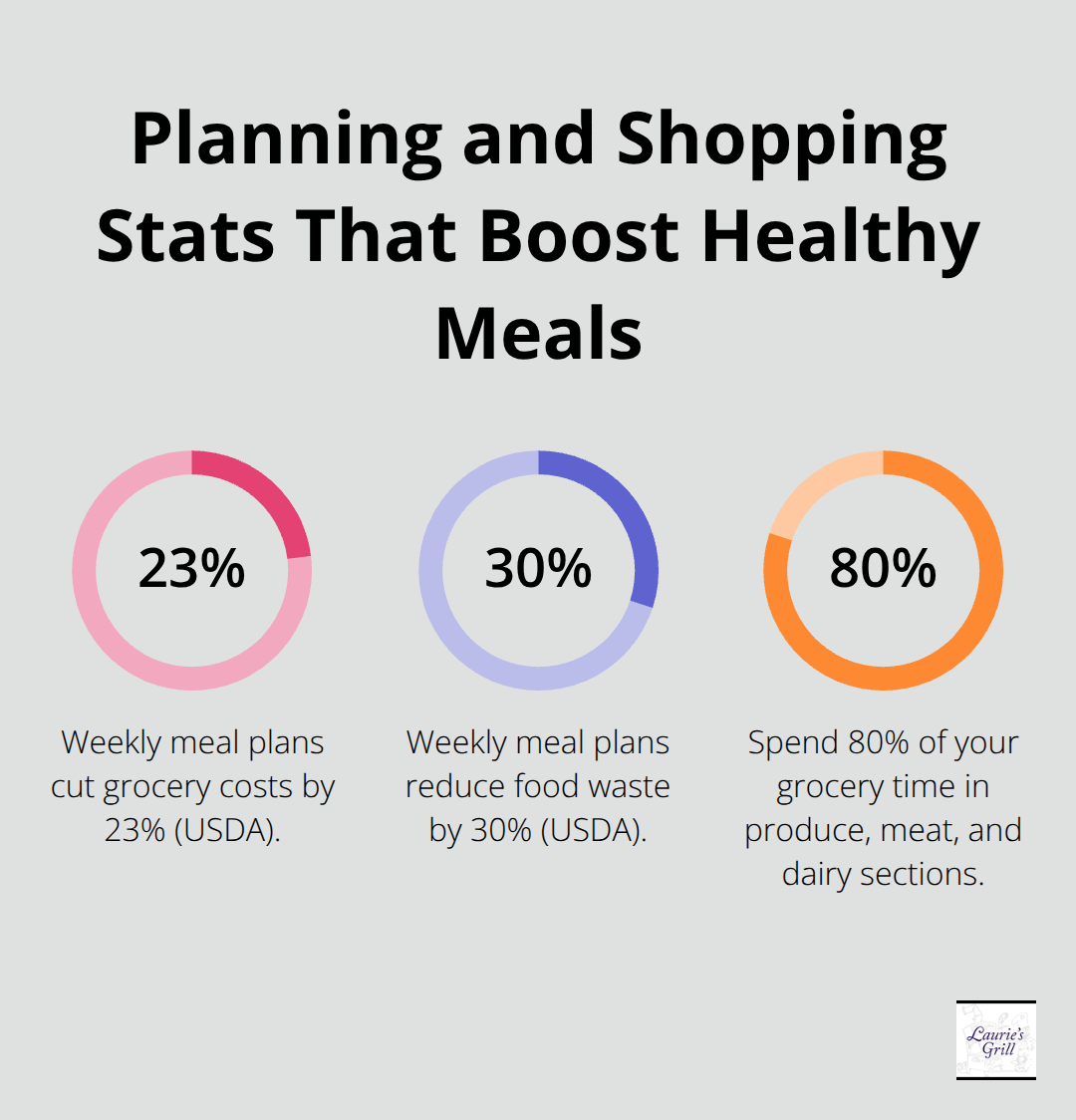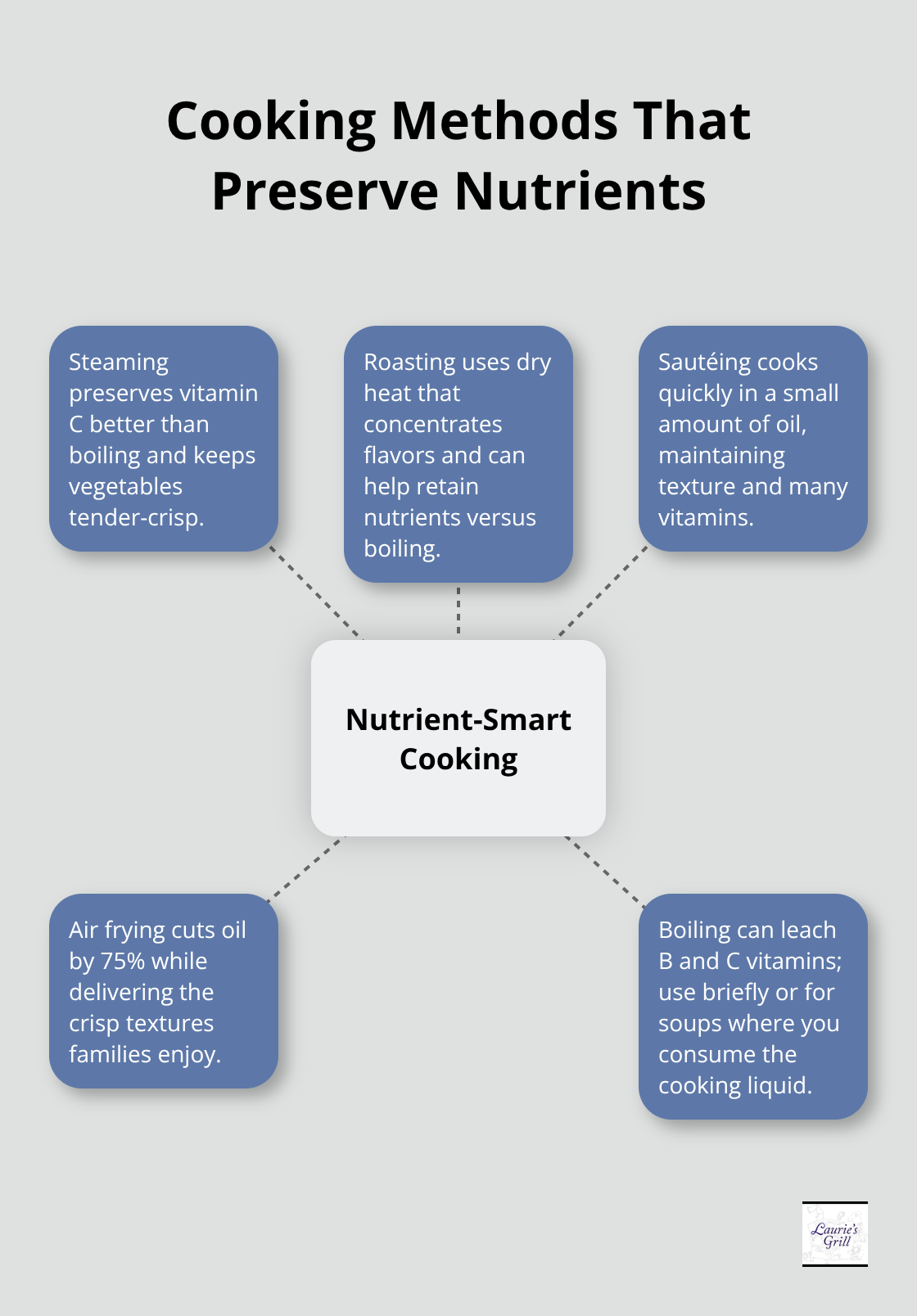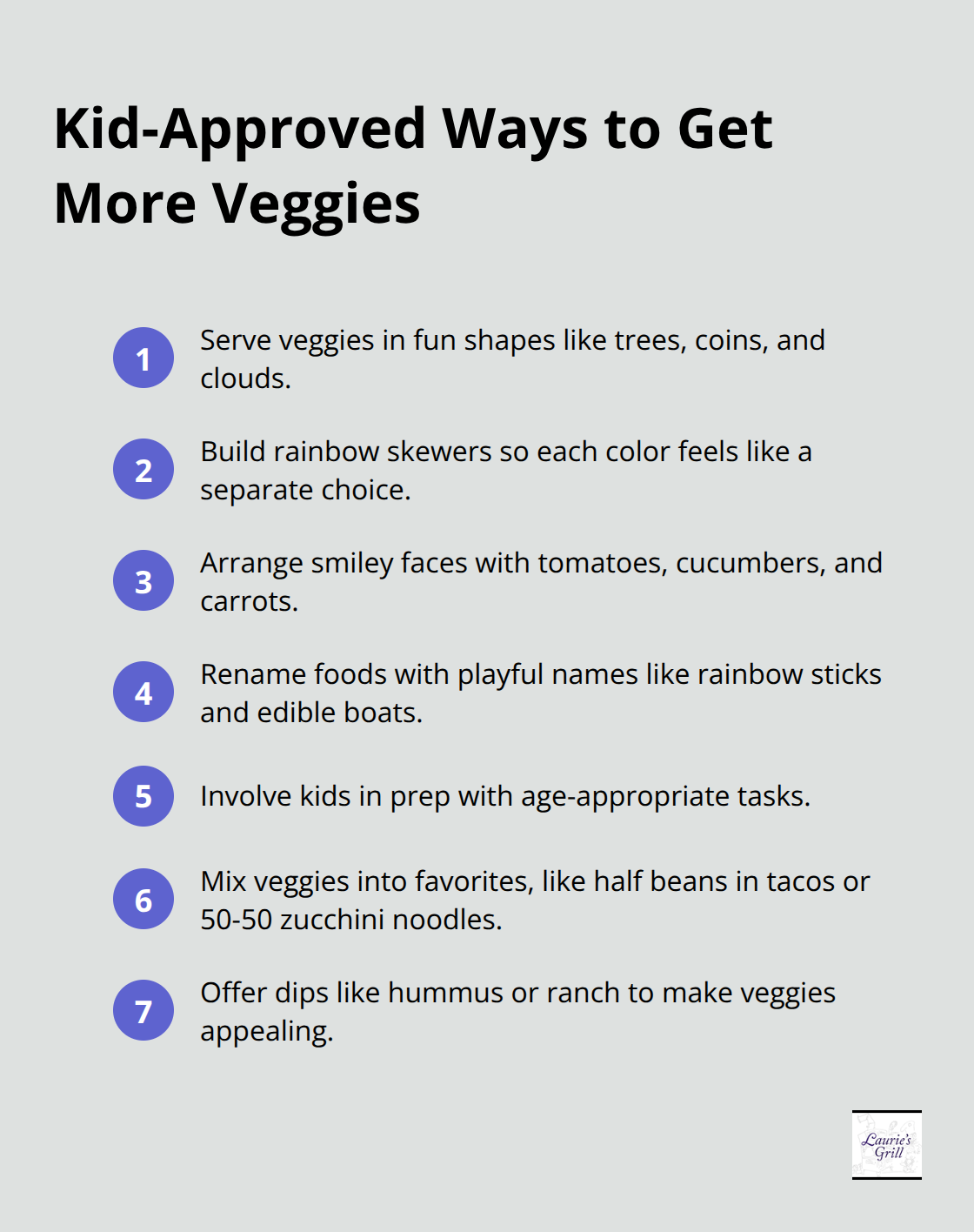Family dinners shouldn’t mean choosing between convenience and nutrition. The average American family eats together only 3.1 times per week, yet research shows shared meals improve children’s eating habits by 35%.
We at Laurie’s Grill believe finding healthy meals to cook for family doesn’t require hours in the kitchen. Smart planning and simple techniques transform mealtime into quality family time while building lifelong healthy eating habits.
How Do You Plan Nutritious Family Meals
Weekly meal plans cut grocery costs by 23% and reduce food waste by 30%, according to the USDA. Start each Sunday by mapping out seven dinners with the protein-starch-vegetable formula. Write down three protein sources, three whole grains, and five vegetables your family enjoys. Mix and match these components to create different combinations throughout the week. Harvard School of Public Health research shows home-cooked meals contain 200 fewer calories than restaurant meals, which makes consistent plans your strongest defense against processed food reliance.
Shop the Perimeter First
Grocery stores place whole foods around the perimeter and processed items in center aisles. Spend 80% of your time in produce, meat, and dairy sections.

Frozen vegetables can have just as many vitamins as fresh options that traveled long distances (perfect for busy weeknights). Buy seasonal produce to save money and maximize nutrients. Winter squash costs 40% less in fall, while summer berries peak in nutritional content during their season. Stock your pantry with brown rice, quinoa, canned beans, and olive oil as foundation ingredients.
Prep Three Days Ahead
Sunday prep sessions save approximately 30 minutes of meal preparation time daily. Wash and chop all vegetables immediately after you shop. Cook grains in large batches and store them in the refrigerator for up to four days. Pre-portion proteins into meal-sized containers and freeze what you won’t use within two days. This system prevents the 5 PM panic that leads families to order takeout (we’ve all been there). Slow cookers and pressure cookers become your best tools for hands-off meals that produce tender, flavorful results while you handle other responsibilities.
These foundation strategies set you up for success, but the real magic happens when you master simple techniques that preserve nutrients and enhance flavors.
Which Cooking Methods Keep Nutrients Intact
Steaming vegetables helps preserve vitamin C content, though boiling destroys most vitamin C in vegetables with retention ranging from 0 to 74%. Steaming, roasting, and sautéing preserve nutrients while they develop rich flavors. Water-soluble vitamins like B and C leach out during boiling, but dry-heat methods like roasting actually concentrate flavors and nutrients.

Air fryers reduce cooking oil by 75% while they maintain the crispy textures families crave.
Master the Art of Salt-Free Seasoning
Fresh herbs contain 40 times more antioxidants than dried versions, which makes them powerful flavor enhancers that boost nutrition simultaneously. Garlic powder, onion powder, smoked paprika, and cumin transform bland chicken into restaurant-quality dishes without added sodium. The American Heart Association recommends families limit daily sodium, but children consume 3,330mg daily on average. Replace half your salt with lemon juice, vinegar, or herb blends to cut sodium by 50% while you intensify flavors.
Choose Herb Combinations That Work
Oregano and basil pair perfectly with tomato-based dishes, while rosemary and thyme complement roasted meats and vegetables. Mediterranean herbs like oregano contain compounds that reduce inflammation (particularly beneficial for growing children). Cumin and paprika add warmth to Mexican-inspired dishes without overwhelming young palates. Fresh parsley brightens any dish and provides vitamin K, while cilantro adds freshness to Asian stir-fries.
Apply Simple Portion Control Rules
Children need roughly half the protein portion of adults, but most families serve identical plate sizes to everyone. Use the palm method for protein portions: adult palm-sized servings for grown-ups, child palm-sized for kids under 12. Vegetables should fill half of every plate regardless of age, while starches occupy one quarter. This visual system eliminates measuring cups and scales while it teaches children proper eating habits. Cornell University research shows people eat 92% of the food they put on their plates, which makes appropriate portions the most effective weight management strategy for families.
These nutrient-preserving techniques work best when you make healthy foods appealing to your pickiest eaters.
How Do You Get Kids to Actually Eat Vegetables
Selective children are more likely to reject foods commonly considered healthy, presenting a diet low in protein, according to pediatric nutrition research. Transform broccoli into trees, cauliflower into clouds, and carrots into coins to make vegetables visually appealing. Cornell University studies show kids eat 70% more vegetables when adults cut them into fun shapes or arrange them in colorful patterns. Rainbow vegetable skewers work better than mixed vegetables on plates because children see each color as a separate choice rather than one overwhelming dish.
Create Visual Appeal That Works
Roasted sweet potato rounds become orange coins, while steamed broccoli trees get dipped in ranch dressing lakes. Cut bell peppers into strips and call them rainbow sticks. Arrange cherry tomatoes, cucumber rounds, and carrot coins into smiley faces on plates. Children respond to familiar shapes and bright colors more than nutritional lectures.

Purple cabbage becomes confetti when shredded, and snap peas transform into edible boats that hold hummus dips.
Turn Meal Prep Into Family Game Time
Children who eat with their families at least four times a week tend to perform better academically, showing the importance of shared meal experiences. Assign age-appropriate tasks: 4-year-olds wash vegetables, 6-year-olds measure ingredients, and 8-year-olds operate can openers safely. Kids develop ownership over meals they help create, which eliminates most dinner table battles. Weekend sessions become quality time that produces multiple meals for busy weekdays.
Replace Rather Than Restrict
Swap white pasta for whole wheat versions gradually. Mix ratios until kids adjust to the nuttier flavor and denser texture. Replace half the ground beef in tacos with black beans to boost fiber content by 6 grams per serving while you maintain familiar flavors. Cauliflower rice mixed with regular rice reduces calories by 25% without dramatic taste changes. Zucchini noodles work perfectly in spaghetti dishes when mixed with traditional pasta at a 50-50 ratio. These substitutions teach children that healthy versions of favorite foods taste just as satisfying.
Final Thoughts
Consistent healthy family meals create measurable benefits that extend far beyond nutrition. Families who share home-cooked meals seven times weekly report 40% lower stress levels and stronger emotional connections. Children from these households consume 35% more fruits and vegetables throughout their lives, which establishes patterns that reduce obesity risk by 20% into adulthood.
The compound effect of these daily choices builds family bonds while it protects long-term health. Parents who prioritize healthy meals to cook for family see their children develop better academic performance and social skills. These shared experiences create memories around food that children carry into their own families (and pass down through generations).
Start with one technique each week rather than complete meal overhauls. Choose Sunday meal plans first, then add herb seasonings, followed by kid-friendly vegetable presentations. We at Laurie’s Grill understand how family meals build community connections, which is why our family-owned restaurant in Bend, Oregon serves home-style meals that bring families together around classic American comfort food.


Recent Comments